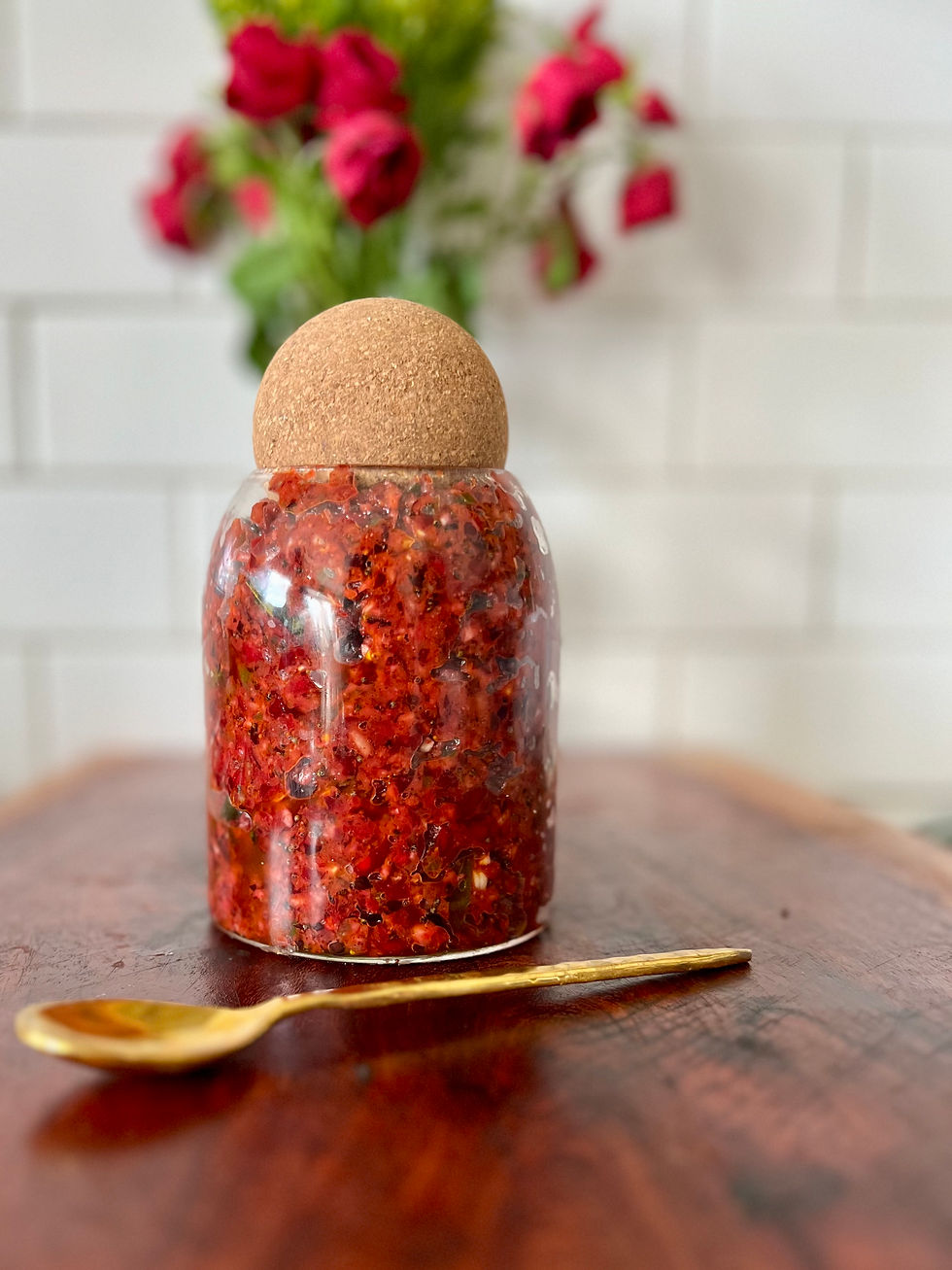Hotte Menasinakai - North Karnataka Style Stuffed Peppers
- Savitha Enner

- Aug 14
- 4 min read

In the vibrant culinary landscape of North Karnataka, Hotte Menasinakai stands as a testament to the region's love for bold flavors and ingenious cooking techniques. This traditional dish transforms humble small peppers into flavor-packed delights by stuffing them with a rich, aromatic mixture of roasted peanuts, fresh coconut, and fragrant spices. The name literally translates to stuffing the belly of the pepper in Kannada. Each home has a unique celebration of this recipe, and this is my Amma’s.
What makes this North Karnataka specialty truly special is its perfect balance of textures and tastes - the slight heat from the peppers beautifully complements the nutty richness of peanuts and the subtle sweetness of jaggery. The addition of niger seed powder (or its alternatives) adds a unique depth that's characteristic of North Karnataka cuisine, making this dish a wonderful representation of the region's culinary heritage.
Ingredients
For the Stuffing:
1/4 cup roasted peanuts
1/4 cup fresh coconut, grated
1/4 cup niger seed powder (substitute: sesame seeds or roasted chana dal)
3 cloves garlic
1 heaping tablespoon coriander powder
1 teaspoon cumin seeds
1 tablespoon tamarind juice
1 tablespoon jaggery
1/2 onion, finely chopped
Salt to taste
For Cooking:
6 small bell peppers (the fresher, the better)
1/2 onion, sliced
1 tablespoon oil (divided)
1 cup water
Additional salt and jaggery to taste
Instructions
Preparing the Stuffing:
Make the spice paste: In a blender, combine roasted peanuts, fresh coconut, niger seed powder, garlic, cumin seeds, coriander powder, tamarind juice, and a pinch of turmeric. Blend into a smooth, thick paste.
Prepare the aromatics: Heat a few drops of oil in a small pan and sauté the finely chopped onions until translucent and fragrant. Allow to cool slightly.
Combine the filling: Mix the sautéed onions into the spice paste and season with salt to taste. The mixture should be moist but not too wet. You. Can also some chopped cilantro to this.
Preparing the Peppers:
Score and clean: Carefully score the tops of each small bell pepper in a cross pattern. Gently remove some seeds from inside, creating space for the stuffing while keeping the pepper intact.
Stuff the peppers: Fill each pepper generously with the prepared mixture, pressing gently to ensure the filling stays in place. Set aside.
Cooking:
Start the base: Heat the remaining oil in a wide skillet over medium heat. Add the sliced onions and sauté for about 1 minute until they begin to soften.
Add the peppers: Carefully place the stuffed peppers in the skillet, arranging them in a single layer.
Create the cooking liquid: Add about 1 cup of water to the skillet, along with any remaining stuffing mixture. Season with additional jaggery and salt to taste.I place the stuffing right onto to the peppers to avoid burning or sticking to the pan. Mix well before serving.
Steam-cook: Cover the skillet with a lid and cook on medium heat for 5-7 minutes. The cooking time depends on the freshness of your peppers - fresher peppers will cook faster.
Check for doneness: The peppers should be tender but still hold their shape. The cooking liquid should have reduced to a thick, flavorful gravy.
Serving Suggestions
Serve these delicious stuffed peppers hot with steamed rice or Indian flatbreads like chapati or jowar roti. The rich, nutty gravy makes an excellent accompaniment with a side of sauteed greens and chopped cucumbers with for Jowar rotti.
Cook’s Tips
Pepper selection: Choose small, firm bell peppers for best results. Fresh peppers not only cook faster but also hold their shape better. A good sub in America are Pablanos. The regu
Niger seed substitute: If niger seeds aren't available, roasted sesame seeds or hurugadale (roasted chana dal) work wonderfully as alternatives.
Consistency matters: The stuffing should be thick enough to hold together but moist enough to blend well with the cooking liquid.
Storage: These stuffed peppers taste even better the next day as the flavors meld together beautifully.
This authentic North Karnataka recipe brings together the earthy flavors of the region in one comforting dish that's perfect for family meals or when you want to explore the rich culinary traditions of South India.
video recipe :https://www.instagram.com/reel/DNVmNOhuOSK/?utm_source=ig_web_copy_link&igsh=MzRlODBiNWFlZA==
Growing this pepper in Zone 7a - America
Early varieties: Jalapeño, Serrano, Hungarian Hot Wax
Medium-season varieties: Cayenne, Thai chilies, Poblano
Longer-season varieties: Habanero, Ghost peppers (with season extension) are super spicy
Start Early Indoors: These seeds were accidentally sourced from India as my sister sent me some chili flakes, and I took a chance and planted them out. Begin seeds indoors 8-10 weeks before your last frost date, but I start them mid-February to have a good-sized pepper to plant out. season. This is especially helpful for superhot varieties that need extra time to mature.I plant them out 1st week of May and fertilize with Plant-tone ( I use Espoma) fertilizer every 2 months. But its necessary to water these plants regularly in the heat of summer for a good harvest. They start yielding mid-July. It's a long waiting period of almost 6 months to harvest peppers.
My fav for sourcing pepper seeds
MI gardeners
Baker creek
seeds of India






Comments